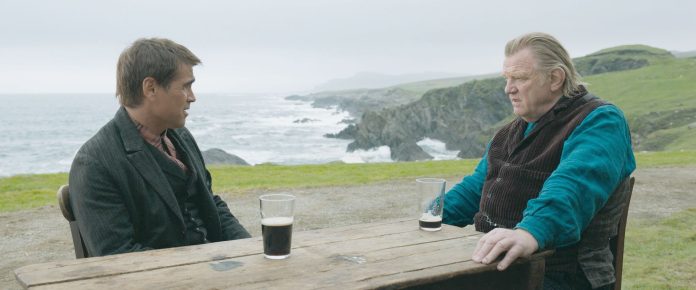Niall Mulholland, East London Socialist Party
The Banshees of Inisherin has garlanded Golden Globe awards and is nominated for nine Oscars. The film by writer-director Martin McDonagh brings together actors Brendan Gleeson and Colin Farrell following their successful 2008 movie, ‘In Bruges’. Set on the fictional island of ‘Inisherin’ in 1923, the new film is about two male friends who abruptly fall out, with dire consequences. It is intended as an allegory for the Irish Civil War (‘Inisherin’ translates to ‘Island Ireland’), which was in full rage at that time.
Colin Farrell plays Pádraic Súilleabháin, a small farmer, and Brendan Gleeson plays Colm Doherty, a fiddle player who scores traditional Irish music.
Sensing that life is marching on, and that he must do more creative work, Colm abruptly ends his daily pub outings with Pádraic. When asked repeatedly by Pádraic why he has taken this drastic action, Colm cruelly tells Pádraic that he is a “boring” and a “limited man”. Other characters include Dominic, a young lad who wants to escape his thuggish policeman father. Dominic has romantic feelings for Siobhán (played by Kerry Condon), Pádraic’s sister, who is the most rounded character in the film.
The more Pádraic desperately attempts to re-establish a friendship with Colm, the more the older man takes drastic action to prevent it, which includes threats to carry out self-mutilation. The falling out escalates into violent actions by both men.
The Banshees of Inisherin has received widespread acclaim for its spare dialogue, beautiful cinematography and acting. As with other Martin McDonagh tragic-comic films, it lends itself to grotesque and cartoonish violence.
McDonagh’s writing is infused with postmodernism, and perhaps audiences are meant to assume he is cleverly subverting Irish stereotypes. But many Irish people will wince at some of the depictions of life on the island that, at times, veer a bit close to the ‘Stage Irish’: Pádraic’s doting love for his donkey which he allows to wander freely inside his cottage; Dominic is the village ‘eejit’; the pub entertains a host of jigging drunks; and an ancient female in a black shawl is the island’s doomsayer.
Most problematic is the politics. References to the Civil War raging on the mainland, as shown by far-off explosions and sounds of gunshots, do little to illuminate why this conflict is taking place. It is treated as an almost inexplicable breach. The policeman is proud to be asked to go to the mainland to help oversee state executions of prisoners yet he says he has no view on the civil war. One character on the island says at least during the war of independence everyone knew they were “fighting the English”, but no one knows what this civil war is all about. The audience, unless they have prior knowledge of the historical events, will be at a loss. Is writer-director Martin McDonagh trying to avoid controversy in modern-day Ireland, where the main two bourgeois parties, Fianna Fáil and Fine Gael – currently in government together, for the first time – have their roots in civil war politics?
To be generous to McDonagh, perhaps Colm’s desire to reject small farmer Padraic can be taken as symbolic of the bourgeois nationalist forces that coalesced around the new Free State in Ireland after partition and ‘abandoned’ the six counties in the north? The fledgling militarised state, backed by British imperialism, fought a ruthless war against the radical republican forces that refused to recognise partition and the bloody creation of the six-county Unionist-dominated northern state and the oppressive 26-country Free State.
The anti-Treaty forces lacked a developed social programme and the mass mobilisation of the working class to win. The Communist International warned, in December 1922, while still under the leadership of Lenin and Trotsky: “Armed struggle alone, without its extension and support through economic and political actions, will end in failure. In order to achieve success, the masses must be mobilised against the Free State.”
Siobhan’s dilemma, between staying living with her brother in a poverty stricken and small-minded community or taking off to the mainland for a job, could be a reference to the mass emigration from Ireland that took place from the 1920s onwards. During this period, the triumphant pro-Treaty Irish bourgeoisie consolidated its rule over an impoverished state and worked hand-in-hand with an ultra-conservative Catholic Church hierarchy.
In reality, the people of the islands of the west coast of Ireland were not, by any means, confused bystanders to events taking place on the mainland. Some of them played an important role in the revolution and counterrevolutionary events between 1913 and 1923.
The renowned Irish novelist and short story writer, Liam O’Flaherty, who was born on one of the Aran islands off the coast of Galway (where Banshees is filmed), was an active anti-Treaty republican, a founder member of the first Communist Party of Ireland in 1921 along with James Connolly’s son Roddy Connolly, and was editor of its weekly paper, the ‘Workers’ Republic’. His brother Tom O’Flaherty, also a writer, emigrated to America where he was active in the Wobblies, an early member of the Communist Party, and a supporter of the American Trotskyist, James Cannon.
Liam O’Flaherty wrote novels and stories set during the civil war, including on the Aran Islands, where he shows the lives of working people affected by the civil war. Now, wouldn’t it be great to see these made into screen adaptations?
- The Banshees of Inisherin is out now on Disney Plus








